First, a Gurlesque 101: “Gurlesque” is a theoretical term that I came up with in 2001 when I was thinking and writing criticism about new poetry by younger American women and started seeing some striking aesthetic similarities among poets who were in other ways pretty different, and didn’t know each other. I like to say that the Gurlesque is a constellation of women artists: viewed from afar, they make a pattern, but up close, they are resolutely individual and distinctive.
The term Gurlesque is meant to echo five other terms that can help you get a gist of what the aesthetic is all about: 1) burlesque, as in vaudeville and stripping and bustiers and drag shows, 2) the grotesque, as in hybrid monsters and bodily fluids and disgust and revolt, 3) riot grrl, as in punk rock women in babydoll dresses and combat boots making their own bands and zines, 4) the carnivalesque, as in Mikhail Bahktin’s literary theory about the carnival as a space for subversion, social upheaval, and joyous, riotous behavior, and 5) girliness, as in ponytails, unicorn obsessions and diaries and secret magic powers and anger and unfairness and you’re not the boss me.
So the Gurlesque is poetry—or other art (paintings, performance, film, music)—that does these things: that flaunts femininity as artifice, as performance, as tease; that is often gross or haunted or disturbing, that says dark and terrible and ridiculous things; that screams and sings; that is cute and punk; that seeks to change the way we see the world; and that puts the girly—the stuff of girlhood, a girly cadence, a girly attitude—at the forefront, showing it to be important, wild, complex and riveting.
In this essay (which is a version of a presentation I gave at a Switchback Books salon in Chicago in 2010), I’m getting the chance to do something I hardly ever get to do: talk about the Gurlesque in relation to something other than poetry. I love that, because when I first started noticing it, I felt like it was happening all across the spectrum of women’s art-making, but I almost only ever talk about it in poetry.
This essay looks at some women rock musicians from the 1970s to today, in roughly chronological order and styled after Roland Barthes’ concise critiques of pop culture, Mythologies, with the hopes that this will further explain what I’m talking about when I’m talking about the Gurlesque. Rock music Gurlesque is of course different than poetry Gurlesque, largely because, in this case, there is something called marketing and something called money involved, and that changes the stakes and the players and the number of people involved with a woman’s image or work. But I hope it will still be fun, and enlightening, to hear about these figures in this way.
There are certainly plenty of other feminine rock stars we could view through the lens of the Gurlesque. Consider this an opening act.
†
Karen Carpenter
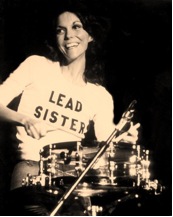
Karen Carpenter is not really Gurlesque, although the figure of Karen Carpenter is proto-Gurlesque and important to talk about (and not just because Kim Gordon’s band Sonic Youth and the queer filmmaker Todd Haynes made art about her, though that counts for something, too). The figure of Karen Carpenter is proto-Gurlesque because it so 70s: I think of the Gurlesque as an aesthetic that begins with a 1970s American girlhood experience, in the wake of Second Wave feminism and sexual liberation and civil rights and the mainstream backlash against all those things and toward order and “niceness” in the form of plastic smiley faces, calico dresses, winged hair, and air-brushed rainbows. Karen Carpenter was so 70s: so nice, so creepy, and so dead. She was the princess of anorexics, the Perfect Girl, a trainwreck. She was a drummer, when you might have expected to her to play the guitar or bang a tambourine. How impossible it seemed that she could even lift a drumstick. How she looked like a drumstick. How impossible the sound, the sound of mist and melancholy, that came out of her mouth, black hollow that nothing entered. Hollow-eyed, hollow-cheeked. The vague perfume of an incest. Angelic skeletal self-murdering drummer superstar.
†
Stevie Nicks
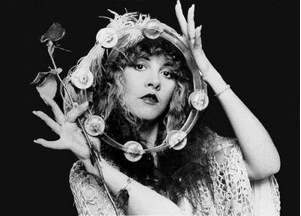
One of the most Gurlesque moments in the history of rock criticism has to be when Courtney Love interviewed her idol, Stevie Nicks, in 1997 in the pages of Spin, and I will never forgot how they talked about how they both liked to throw colored silk scarves over the lamps in their bedrooms. What a triumphant moment of bizzaro, powerful feminine domesticity for these two fucked-up, ambitious, deep-throated, beautiful addict-icons to be giddily chatting about their shared taste in home decor in a national music magazine.
But oh my god, Stevie, where to begin? The all-white dripping organza outfits, or the all-black dripping organza outfits? The baby face that never seems to change under all that frizzed-out romantic hair? The twirling? The boy’s name? The rose-colored Porsche? The songs about Welsh witches and cocaine abuse? The self-indicting songs about sleeping around and being a bitch? Writing about yourself as a goddess, a witch, a queen, a dragon, a black widow? Who did that then? Who does that now?
When I was in middle school I knew a bad girl in my synagogue youth group, the younger sister of a girl with alopecia who had once babysat for me. This girl wanted to be you, Stevie, with her eyeliner and her black t-shirts and her tight jeans and her cigarettes, and she looked like you, to be honest, and when I told her that it made her day, it made her year, it made her life, that someone had noticed that she wanted to be Stevie and that maybe a tiny bit of her was Stevie. For girls everywhere who start out as the cutie in front with the mic and end up supermegarock stars that eclipse everyone in their orbit, there is Stevie.
†
Poly Styrene
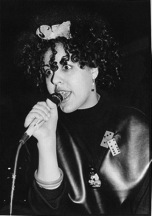
Pretty rad name she gave herself, isn’t it? Look her up. Multiracial, beautiful, and at the time chubby and with braces on her teeth, often performing in plastic dresses or military helmets, she led a late 70s British punk band, the X-Ray Spex, when she was just a teenager. Led a bunch of white guys and sometimes a girl saxophone player. The X-Ray Spex recorded one full-length album, Germfree Adolescents (which is a kick-ass Gurlesque name for an album). Poly wrote all the songs herself, the words and music, and the songs are gorgeous, catchy, anti-melodic melodies against Nazism and consumerism and injustices of class and race and gender. Incredible, ahead-of-their-time, never quite matched punk anthems of adolescent angst and real political power. Probably her most famous song begins with her saying, as you can see in this video, “Some people say little girls should be seen but not heard, but I say, OH BONDAGE, UP YOURS!”
After their album came out, Poly had a schizophrenic break, saw a pink light and heard the crystalline voices of everything she touched, and became a Hare Krishna.
†
Kate Bush
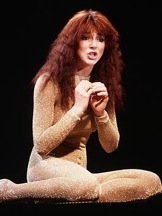
Freako ballerina singing through the haunted halls of the Gurlesque canon: about Bronte, ghosts, sad girls on the moors; about suicide and incest and pregnancy; about agoraphobia and psychoanalysis. Sometimes in drag, in tuxedo or fedora, sometimes in glitter golden catsuit or pink leotard. Twirling or en pointe like a Gothier Stevie, her crazy dance moves like something I do in my kitchen.
Kate was nineteen when she recorded “Wuthering Heights,” and she wrote it herself. It’s a good song, a weird fucking song.
Ghost girl with red fingernails. Zombie arms with angel sleeves. Grand piano strewn with roses and ivy. Long thick hair. Almost cheesy if it wasn’t so freaky and sexy, if she wasn’t such a vamp, such a tramp.
And the voice. Something out of Rocky Horror Picture Show, only it seems like she’s serious. Is she serious? That voice. Without Kate Bush there would be no Joanna Newsom.
†
Bjork
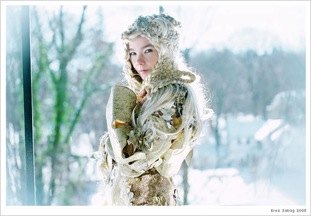
In Lars Von Trier’s “Dancer in the Dark,” she is hanged and she is blind and she is still singing. It looked so awful and was so awful and she gave it all she had, all she did not have. A martyr playing a martyr: performing. Was it a joke?
Who taught her to be Bjork?
She is the Worst-Dressed, always, dressed to mess with you, and wins awards after awards for it. A swan. A bear. A mermaid. One hundred percent nymph, child star, mother, partner of maybe one of the most Gurlesque male artists: Matthew Barney, former male model, satyr, castrata. Bjork looks unwashed, high. She looks gorgeous, pure. She looks like Pippi Longstocking with those deep-set eyes. I can’t understand what she’s saying. She’s screaming and sighing. She sings about eating and crashing. She’s very foreign, from a country made of glass, I think. She walked out of a fairytale and into a music video.
†
Courtney Love
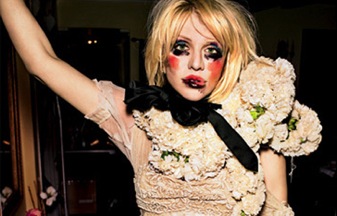
The urban legend I heard is that Courtney Love is one of the naked children on the cover of Led Zeppelin’s Houses of the Holy, which, although completely untrue, seems plausible because of her wild girlhood.
The urban legend I heard is that a musician named Lois Maffeo knew Courtney Love when they were both little girls, and thought her name was the most beautiful name in the world (as I also probably would have thought had I known her as a little girl), so later when she had a little lo-fi band, Lois called her band Courtney Love. At least part of this is true: I had records by the band Courtney Love before Courtney Love herself was in a band. So Courtney Love was the name of a band before she ever recorded a song.
The stranger-than-fiction truth is it was found out later that Courtney Love’s mother’s own mother was an artist, the writer Paula Fox, who, following her own brutal childhood, gave her daughter up for adoption. The truth is Courtney’s father was a roadie for the Grateful Dead.
Courtney Love was cast in a bit part as Nancy Spungeon’s groupie punk junkie friend in the movie Sid & Nancy. This was four years before she even met Kurt. The crazy irony of the drugs, the overdose, suicide, the celebrity, the legend, of Sid & Kurt.
For all these alchemical reasons, and for so many more—the commune childhood, the LSD childhood, the Sylvia Plath-reading childhood, and later, the look of the smeared lipstick, the black-markered SLUT across her stomach, the kiddie barrettes in the bleach blond hair, the drugs, the marriage, the drugs, her daughter Frances Bean (named Frances Farmer), the drugs, the suicide, the suicide note, the wailing public reading of the suicide note, the songs, the band name Hole, the paparazzi, the drugs, “I’m Miss World, Somebody Kill Me Please,” the nose job, “Doll Parts,” the lesbian best friend, the transformations—Courtney Love is Gurlesque.
†
Joanna Newsom

At first I did not cotton to Lady Joanna. She seemed too much, and I couldn’t take the voice. But I’ve been born again, and now I see the light: the elf ears, the misty mountain hippie homestead, the harp (the harp!), the Laurel Canyon/Renn Faire dresses, the arcane and trippy vocabulary, the lines about “salty pyres,” “puking birds” and “milky moons,” “mica-spangled” “swansdown and leather.” (“Swansdown and leather” might as well be a Gurlesque tagline.) And photo shoot after photo shoot in bohemian splendor, in crushed velvet, in furs and braids, flowers in her hair, all in the context of naked ambition, of chops, of staying put, of leave me alone, of prodigy. I no longer can resist to the goldrush fairy genius maiden.
†
CocoRosie
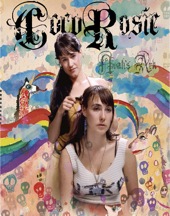
Is it because they are real-life sisters? Real-life multiracial sisters who like to wear mustaches and pose for publicity photos while doing each others’ hair? Maybe it’s because they are stunning, possibly incestuous sisters that we love CocoRosie. And so, to explain why CocoRosie are Gurlesque (other than the reasons already stated), I plagiarize the following descriptions, which are as good as anything I’ve written to explain my own theory.
In an article titled “Twisted Sisters” by Fernanda Eberstadt in the New York Times, from 2008: “The music of CocoRosie is most often categorized by critics as “freak folk,”...singer-songwriters...who have revived the ’70s culture of homemade authenticity with at once more wholesomeness and more joyous perversity than their elders. But CocoRosie’s sound — the effects they deploy include windup toys and a kitten’s mewling, as well as more conventional instruments like a snake charmer’s flute, an out-of-tune ukulele or a beat box — is a little freakier, even, than that of most of their colleagues. It’s no accident that their professed patron saints are drag queens from the 1970s: the German countertenor Klaus Nomi, who became an East Village cabaret star, or the Cockettes, a San Francisco-based operetta troupe whose most famous film was a transvestite version of Tricia Nixon’s wedding.
As was true for their cross-dressing heroines, costume is an essential part of the performance. Both Bianca (Coco) and Sierra (Rosie) are exquisitely beautiful, but their habitual get-up is so in-your-face ugly you’d think the aim, as with primitive warriors, was to scare away the enemy.”
And then this, from an unsigned squib in the September 20, 2010 of the New Yorker: “The duo is as much a visual enigma as a sonic one. Their look—tracksuits, mustaches, boxer shorts, headdresses, corsets, all homemade—could be described as tribal vaudevillian folk-hop, and the music is something like that, too. Their songs are often catchy, and always strange—deranged, even: like dolls that come alive and haunt your dreams.”
†
Lady Gaga
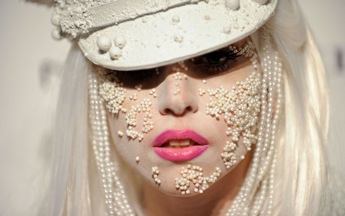
Yes, some of the videos have unicorns in them. Yes, in one video she murders people while looking really cute and scary and hottie. Yes, she is a phenomenon who owes a ton to avant-garde performance art and queer culture. But I resist calling her Gurlesque.
Here’s Joanna Newsom, who seems to feel the same way about Lady Gaga that I do: “My problem isn’t actually with Lady Gaga. But there’s not much in her music to distinguish it from other glossy, formulaic pop. She just happens to wear slightly weirder outfits than Britney Spears. But they’re not that weird – they’re mostly just skimpy. She’s fully marketing her body/sexuality; she’s just doing it while wearing, like, a ‘fierce’ telephone hair-hat. Her sexuality has no scuzziness, no frank raunchiness, in the way that, say, Peaches, or even Grace Jones, have – she’s Arty Spice! And, meanwhile, she seems to take herself so oddly seriously, the way she talks about her music in the third person, like she’s Brecht or something. She just makes me miss Cyndi Lauper.” I couldn’t have said it better myself, Joanna dear.
And I’ll go one step further to say that because Lady Gaga’s sexuality has no scuzziness, and because I find her songs boring as hell without the costuming, and because the videos actually deeply disturb me in their reification of glamorized violence against women, there is nothing truly fresh, truly Third Wave about her. So even though I applaud her efforts on behalf of the gay community, to which she seems truly dedicated (stereotypical prison-dyke video references notwithstanding), and even though apparently she writes her own songs, Lady Gaga mostly comes off as a packaged pop star, a skinny girl wearing no pants.
†
The “Why Do You Let Me Stay Here?” Video
by She & Him
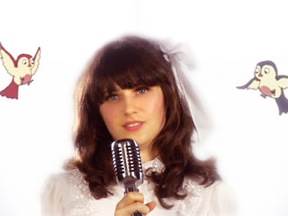
I offer a last note in the form of a short critique of a video by Zooey Deschanel and M. Ward. I’m not saying She & Him, their band, is Gurlesque. I don’t really think they are, though I have liked Zooey for a long time, ever since her role in “Almost Famous,” in which she was noticeably un-actress-like in an awkward, believable, sort of hyperreal performance as the big sister who turns her brother on to good music. But anyway, the first version of the “Why Do You Let Me Stay Here?” video, directed by horror movie buff Ace Norton, is uber-Gurlesque. Here’s my shot-by-shot analysis.
White empty space. An opening shot, easy to miss, of nude female legs in an expanding pool of blood (shades of Duchamp’s “Etant Donnes”). Zooey in Karen-Carpenter-ish glowing light, white dress, hair bow, retro microphone; Snow White animated birdies hover nearby. Zooey topples off a giant installation of the word WHY, and lies in a bleeding heap while M. Ward walks on and looks indifferent. A ghost version Zooey cheerfully pops up out of her bleeding body, just as pretty but with darker circles under her eyes, and she keeps singing, mincing around cutely like a Grand Old Opry star. A bunch of animated Pac-Man ghosts zoom past her. A bunch of undead Zooeys in Catholic schoolgirl uniforms rise from the ground. Now in a black strapless prom dress, Zooey happily plinks out the tune on a piano. She is accompanied by skull-faced nuns playing xylophones while a dead version of her, still gushing candy-apple-red blood, droops over the top of the piano. Now Zooey is an adorable cowgirl with a big cut-out heart on her chest who gets shot by M. Ward and begins bleeding from this new wound, but unphased, spurting blood, keeps dancing and singing. She twirls and skips around like a little kid in her black prom dress, past herself in the white 70s dress. Then she’s a bride in a shiny mini wedding dress and veil with an axe in her back, another animated bleeding wound, swinging her microphone all chipper past some zombie Texas two-steppin’ cowboys, past more Pac-Man ghosts. And now she looks like Mary Tyler Moore in a pink blouse and white skirt, with two bango-players in homemade ghost costumes as back-up. She dimples and preens; she tosses an axe and beheads four other versions of herself, all of whom start bleeding. To the words “You make me feel like I am just a child,” she hops and jumps around kindergarten-style, then multiplies into Lilliputian versions of her child self around her own go-go-booted bleeding corpse. M. Ward squashes one of the child-Zooeys like a bug with his shoe. A Pac-Man ghosts eat garbage out of a trashcan while multiple Zooeys prance around. M. Ward is carried off to a heaven with male angels while bridal Zooey flicks away more Pac-Man ghosts. Zooey winks and an animated star comes out of her eye. She blows a kiss and pink animated hearts fly from her mouth. Her ghost-self lies back down into her corpse, and as the video ends, animated vultures come and begin to peck at her lifeless body.
That’s a pretty good Gurlesque 101 right there in that one video.
†
I haven’t spoken here of riot grrl band Bikini Kill, or Goth icon Siouxsie Sioux, or indie folk singer Kimya Dawson. This essay could continue, will continue, because another freakazoid girl rock singer or band out there soon that embraces spectacle and mayhem, that does something completely kooky and wild and upsetting and girly and beautiful and scary and original and artistic. Oh, bondage, up yours, indeed.